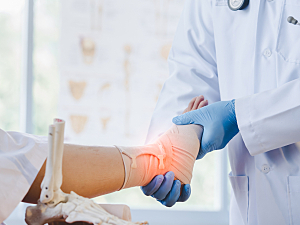Infections after orthopedic surgery are a serious challenge, even in tertiary centers. Bacteria such as Streptococcus and Pseudomonas can form sections of necrotic bone where there is low penetrance by antibiotics, given the limited vasculature. In most cases, biofilms form and limit the efficacy of antibiotics.
The FDA has approved antibiotic-eluting bone cement spacers to treat these infections. However, none of the drugs used—vancomycin, gentamicin, tobramycin, or clindamycin—were originally developed for local delivery from bone cement. Furthermore, resistance has emerged against these antibiotics.
Researchers at Brigham and Women’s Hospital rationally designed a new antibiotic, VCD-077, to be physiochemically compatible with standard bone cement for local treatment of orthopedic infections with much less chance of resistance. Hae Lin Jang, PhD, principal investigator of the Jang Laboratory for Developing Advanced Biomaterials and Biotechnologies in the Center for Engineered Therapeutics at the Brigham, Shiladitya Sengupta, PhD, co-director of the Center, and colleagues describe proof-of-concept studies of the drug–device combination in Nature Biomedical Engineering.
Development and Initial Testing
The team started by designing a “library” of novel antibiotic molecules based on fluoroquinolones, which attain high concentrations in bone.
Because bacteria can become resistant to fluoroquinolones, the researchers experimented with including two other compounds in each molecule. They reasoned that bacteria are unlikely to develop resistance if it’s necessary to mutate two distinct targets.
Of 17 molecules screened in vitro, a nitrofuran-based fluoroquinolone called VCD-077 and a nitrothiazole-based fluoroquinolone called VCD-068 exhibited the greatest inhibition of:
- Quinolone-sensitive and -resistant Staphylococcus strains
- Methicillin-resistant S. aureus
- Fluoroquinolone-resistant S. aureus (QRSA)
- Clinical isolates of QRSA that were methicillin-sensitive or -resistant
VCD-077 was the least toxic to human osteoblasts and had a wider therapeutic window, so it was selected for more research.
Further In Vitro Testing
In additional laboratory experiments, the research team found VCD-077:
- Interacted only minimally with cytochrome P450 enzymes and was associated with minimal changes in liver and kidney function
- Was more effective against biofilms than gentamicin or vancomycin
- Did not interact with polymethylmethacrylate (PMMA) bone cement
VCD-077–loaded PMMA exhibited desired drug-release kinetics, no loss of the mechanical characteristics of the bone cement, and no loss of efficacy of the drug.
In Vivo Testing
The new drug–device combination was superior to gentamicin-loaded bone cement at preventing colonization by Staphylococcus in a rat model of tibial injury. VCD-077–loaded PMMA also decreased the Staphylococcus infection load in a rat model of chronic osteomyelitis, comparing favorably with gentamicin- and rifampin-loaded bone cement.
Furthermore, VCD-077 in bone cement resulted in local concentrations of the drug that exceeded the minimum inhibitory concentrations, which is desirable to retard the development of resistant strains in addition to killing bacteria. Systemic concentrations were below detectable limits.
Toward Clinical Translation
PMMA is already FDA-approved and the gold standard for use in orthopedic procedures. That will speed regulatory approval of the innovative combination product if it proves clinically safe and effective.
Local application of VCD-077-loaded bone cement could emerge as a next-generation therapy that integrates bone-specialized local delivery with minimal systemic exposure, consistent with emerging guidelines for antibiotics stewardship.
